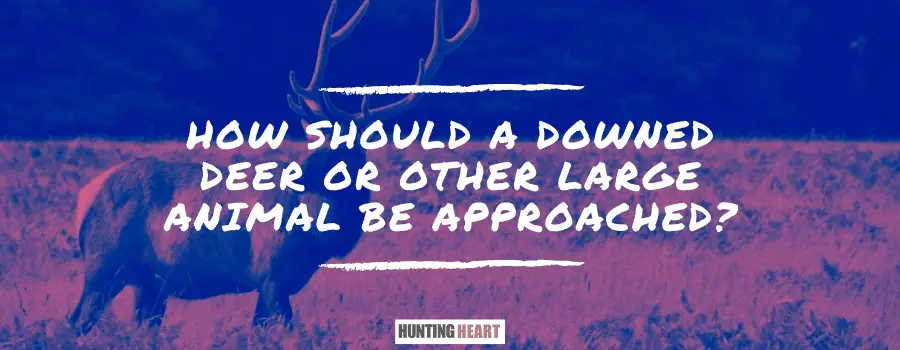As an Amazon Associate I earn from qualifying purchases.
Our Associate portal can be found here
There are lots of hunting shows that can sometimes be misleading. The truth is when approaching a deer and other large animals that you might presume is dead you must do so with caution. There are some serious do’s and don’ts that you must consider before approaching any downed wild animal.
Conventional wisdom dictates that you at least wait for close to half an hour before embarking on the pursuit of your deer. The idea is that the wounded animal rarely dies right away, and patience gives it space and time to expire. It means that you will not spike its system with adrenaline that might cause it to run farther. By waiting, the deer beds down and eventually bleeds out which helps your recovery if you follow the blood trail.
Approaching Downed Game
The animal may appear to be dead when it is not and this makes it very dangerous. The rule to safety is to never approach a downed deer head-on, no matter how dead you think it is. If it is still alive, when it tries to escape it may run in the direction its head is pointing. And that is towards you. If you stand in the way it might gore you with its antlers or run you over.
You should also never attempt to poke it in the eye to see if it will blink.
Downwind
Always approach deer from downwind. The rule of stalking applies when trailing wounded deer. If it is still alive and it catches your smell, it will panic and flee.
When approaching the deer from its rear, stop at a reasonable distance. You can stand slightly away from the animal and toss a piece of wood or any object to see if it moves so that you can take an additional shot.
You should always prepare for a second shot and that is why your rifle or bow and arrow should be in place as you close the distance.
Observe its Rib Cage
If the chest of the deer or animal is heaving, then it is still alive. If you cannot detect rib cage movement, check the animal’s eyes. Dead animals do not close their eyes and they should be wide open. If the eyes are closed, then it is not dead and you should take a second shot. Deer die with their eyes open, and after death, a blue haze appears in them.
Check for Nerves
Hunters often bump or touch animals at the base of their tails to check for nerves. If the animal is still alive, hitting the nerves will make it react and you will know if a second shot is necessary. You can use a stick to bump the animal above the base of the tail. Using a rifle barrel or an arrow leaves you defenseless and in a helpless position if the animal jumps up and takes off.
If you see any movement from the downed deer, you must take another shot, and from a close range, you should be able to deal a final blow. Aim at the base of the skull where it meets the spinal column, or at the heart and lung area.
Some hunters are tempted to pose with their catch. But the safest way to do so is by confirming that the animal is dead. You can then rush in and field dress your deer to ensure the venison meat is preserved well.
How to Get a Deer Out of the Woods
If your primary objective of hunting deer is to catch tasty meat that will last for the long haul, then you must get well versed with field dressing your animal. The importance of this critical step is undeniable and must be followed to the latter if you want to avoid risks to your health. It is also the best way to ensure the longevity of the meat.
Normally when you get your deer after shooting it there are factors you must consider. First, you will want to field-dress the deer, drag it out, load it into a truck, and drive it to a processor. Through all these steps you must ensure you keep the meat clean and protected.
If the deer is small, you can probably get away with no field dressing provided you get it to a processor right away. If it’s bigger, field dressing will significantly reduce its weight making it easier to get out of the woods and into your vehicle.
Field Dressing Deer and Other Large Animals
Field dressing decreases the chance of spoilage as it cools the meat faster and gets the blood out of the cavity. It is especially important if the deer has lots of internal bleeding from the shot.
The process for field dressing may differ slightly as it depends on the size of the animal. For large animals and deer, you will cut from the anus to the breastbone. It gives you full access to the deer’s body cavity, which gives you easy access to the internal organs which makes removing them an easy process. The precise cut also exposes more of the animal to the cool air, which helps drop the temperature of the animal. You should check out our article on How to Cape a Deer for an exclusive procedure.
The process for field dressing smaller animals is not different from that of large game. The slight difference is that you need an extended incision to get more access to the organs. However, in both cases, after removing all the internal organs, you should get the meat to a cool and well-ventilated area to complete the butchering process.
Field Dressing Deer Mistakes to Avoid
Delaying the Inevitable
Most rookie hunters get overwhelmed with their kill and eagerly charge off in pursuit of the deer when they suspect a hit. They hardly give the animal time to succumb yet after they acquire it they will want to parade their kill all day in the back of the truck before dressing it out.
The mistake depends on how the animal was shot. The quality of the meat also depends on how much stress it was under before its death. Sometimes warm weather also contributes to the overall meat’s taste.
A whitetail deer has a well-insulated body, especially if the animal is fat, big, and has its winter coat. Even in cool air temperature, it will still take a long time for the body heat to dissipate from the carcass. The disadvantage with high temperatures is that they quickly turn a few harmful bacteria into many.
There is no need to drag the un-gutted critter around all day if you can avoid it. There is no upside in delaying your field dressing. The organs need to come out eventually, so just get it over with.
Improper Cleanup and Beyond
Cleaning up the deer is a vital process. Even after dressing out the deer, you must clean the meat before dining on the juicy back strap. It is a simple process that has a lot to do with the quality of venison you will feast on.
First off, you must find clean water as soon as possible to wash the carcass before all the blood dries. I insist on the point of having clean water. Clearwater may be filled with parasites that might get you sick. Not all clear water is clean water. Therefore, no water beats using the wrong water. Fresh snow is an alternative and you can use it to scrub the interior of the now gutted deer.
Cutting without a Clue
Before you start working on the animal, you must make a quick assessment. The best way is to find out which organs are punctured. Then move the carcass from its position so that you can have an easy time field dressing.
Hacking your way will not reduce the time that it should have taken to field dress the carcass well. If you hack the wrong parts and send bone chips all over the meat then you will just use more time. The best way to start your field dress is by following a strict pattern. It ensures the venison meat is preserved.
Slow and steady is helpful and also ensures your safety when handling a sharp knife. The most challenging part of field dressing is that you have to operate more on feel than by touch. Therefore you must know its anatomy as it is more reliable than sight. Typically your hands are out of your sight inside the deer’s body cavity. No need to rush or make sudden movements. When in doubt, you should back out and think before cutting.
Most Popular Deer Hunting Accessories
Conclusion
When you are out hunting deer, you have time, effort, and money invested in every shot. Therefore taking the right approach when field dressing a deer or other animal will help you get a tasty reward. With a good plan and the right equipment, the odds of a successful hunt are high. The best way to preserve your trophy and delicacy is knowing what to do at the right time and every stage of the hunt.
Amazon and the Amazon logo are trademarks of Amazon.com, Inc, or its affiliates.

36 years old, been hunting and fishing my entire life – love the outdoors, family, and all kinds of hunting and fishing! I have spent thousands of hours hunting hogs and training hunting dogs, but I’m always learning new stuff and really happy to be sharing them with you! hit me up with an email in the contact form if you have any questions.



